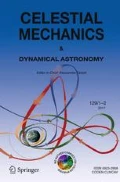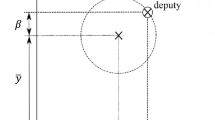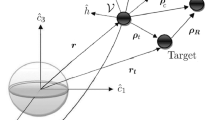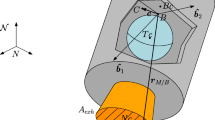Abstract
A novel two-phase hybrid controller is proposed to optimize propellant consumption during multiple spacecraft rendezvous maneuvers in Low Earth Orbit. This controller exploits generated differentials in aerodynamic drag on each involved chaser spacecraft to effect a propellant-free trajectory near to the target spacecraft during the first phase of the maneuver, and then uses a fuel optimal control strategy via continuous low-thrust engines to effect a precision dock during the second phase. In particular, by varying the imparted aerodynamic drag force on each of the chaser spacecraft, relative differential accelerations are generated between each chaser and the target spacecraft along two of the three translational degrees of freedom. In order to generate this required differential, each chaser spacecraft is assumed to include a system of rotating flat panels. Additionally, each chaser spacecraft is assumed to have continuous low-thrust capability along the three translational degrees of freedom and full-axis attitude control. Sample simulations are presented to support the validity and robustness of the proposed hybrid controller to variations in the atmospheric density along with different spacecraft masses and ballistic coefficients. Furthermore, the proposed hybrid controller is validated against a complete nonlinear orbital model to include relative navigation errors typical of carrier-phase differential GPS (CDGPS). Limitations of the proposed controller appear relative to the target spacecraft’s orbit eccentricity and a general characterization of the atmospheric density. Bounds on these variables are included to provide a framework within which the proposed hybrid controller can effect an extremely low propellant rendezvous of multiple chaser spacecraft to a desired target spacecraft.
Similar content being viewed by others
Abbreviations
- a T :
-
Target spacecraft semi-major axis
- c :
-
Coefficient in Schweighart–Sedwick equations
- \({C_{D_T}}\) :
-
Target spacecraft drag coefficient
- \({C_{D_{C_i}}}\) :
-
ith chaser spacecraft drag coefficient
- \({^O{\bf r}_{C_i}}\) :
-
Relative position vector of the ith chaser spacecraft in LVLH orbital frame
- \({^O{\bf v}_{C_i}}\) :
-
Relative velocity vector of the ith chaser spacecraft in LVLH orbital frame
- ΔBC :
-
Ballistic coefficient differential
- \({\Delta BC_{C_i,\max}}\) :
-
ith chaser spacecraft maximum ballistic coefficient differential which corresponds to the maximum relative acceleration differential
- \({\Delta BC_{C_i,\min}}\) :
-
ith chaser spacecraft minimum ballistic coefficient differential which corresponds to the minimum relative acceleration differential
- Δt :
-
Time interval used in fuel-optimal control solution
- Δt opt :
-
Waiting time between re-solving the fuel-optimal low-thrust control sequence
- Δt*:
-
Switching time for the differential-drag controlled rendezvous phases
- ΔV :
-
Metric for fuel consumption expressed in terms of total velocity variation
- ECI:
-
Earth centered inertial coordinate frame
- e 0 :
-
Time-varying eccentricity of the Harmonic Oscillator Motion before Rendezvous
- e T :
-
Target spacecraft orbit eccentricity
- \({{\bf \Phi}(t)}\) :
-
State transition matrix for relative motion equations
- \({\phi}\) :
-
Phase of forcing term in out-of-plane motion in Schweighart–Sedwick equations
- h(t 0):
-
Target spacecraft initial altitude above the Earth surface
- I :
-
Metric for fuel consumption expressed in total impulse
- I nxn :
-
nxn Identity Matrix
- ISS:
-
International Space Station
- i T :
-
Target spacecraft orbit inclination
- J 2 :
-
Second-order harmonic of Earth gravitational potential field (Earth flattening) [108263 × 10−8, cf. Vallado 2004]
- J :
-
Cost function
- LVLH:
-
Local Vertical Local Horizontal
- l :
-
Coefficient in Schweighart–Sedwick equations (out-of-plane motion)
- λ r :
-
Position co-state vector
- λ V :
-
Velocity co-state vector
- m T :
-
Target spacecraft mass
- \({m_{C_i}}\) :
-
ith chaser spacecraft mass
- ν T :
-
Target spacecraft orbit initial anomaly
- ω :
-
Target spacecraft orbital angular rate
- ω T :
-
Target spacecraft orbit argument of perigee
- Ω T :
-
Target spacecraft orbit right ascension of ascending node (RAAN)
- Ψ(t):
-
Convolution integral matrix for relative motion equations due to optimal unbounded control
- q :
-
Coefficient in Schweighart–Sedwick equations (out-of-plane motion)
- \({R_\oplus}\) :
-
Earth mean radius (6378.1363 km, cf. Vallado 2004
- r T :
-
Target spacecraft reference orbit radius
- ρ :
-
Atmospheric density
- S T :
-
Target spacecraft cross-wind section area
- \({S_{C_i,\min}}\) :
-
ith chaser spacecraft minimum cross-wind section area
- \({S_{C_i,\max}}\) :
-
ith chaser spacecraft maximum cross-wind section area
- \({S_{C_i 0}}\) :
-
ith chaser spacecraft cross-wind section area to achieve zero ballistic coefficient differential
- S P :
-
Single drag plate cross-wind section area
- σ pos :
-
Variance of the relative position errors
- σ vel :
-
Variance of the relative velocity errors
- t :
-
Time
- u :
-
Control vector
- u x , u y , u z :
-
Control variables expressed as relative accelerations in the LVLH orbital frame
- V r :
-
Spacecraft velocity vector magnitude with respect to the Earth’s atmosphere
- x :
-
Spacecraft relative state vector
- z :
-
Transformed spacecraft relative state vector
- z 1,tol, z 2,tol :
-
Tolerances in reaching a stable orbit
- t 0 :
-
Initial time
- t f :
-
Final time
References
Bordner R.E., Wiesel W.E.: Trajectory estimation for satellites clusters. J. Guid. Control Dyn. 29(1), 172–178 (2006)
Bevilacqua R., Romano M.: Optimal guidance of proximity maneuvers for a spacecraft with hybrid on-off continuous and impulsive thrust. AIAA J. Guid. Control Dyn. 30(4), 1175–1178 (2007)
Bevilacqua R., Romano M.: Rendezvous Maneuvers of multiple spacecraft using differential drag under J2 perturbation. AIAA J. Guid. Control Dyn. 31(6), 1595–1607 (2008)
Bevilacqua, R., Romano, M., Curti, F.: Decoupled-natural-dynamics model for the Relative Motion of two spacecraft without and with J2 perturbation. Accepted for publication, to appear on the Nonlinear Dyn. Syst. Theory (2009)
Campbell M.E.: Planning Algorithm for Multiple Satellite Clusters. J. Guid. Control Dyn. 26(5), 770–780 (2003)
Clohessy W.H., Wiltshire R.S.: Terminal guidance system for satellite rendezvous. J. Aerosp. Sci. 27(9), 653–658 (1960)
De Ruiter, A., Lee, J., Ng, A.: A Fault-tolerant magnetic spin stabilizing controller for the JC2Sat-FF Mission. AIAA guidance, navigation and control conference and exhibit, Honolulu, Hawaii, 18–21 August 2008.
Ferguson, P., et al.: Formation flying experiments on the Orion. AIAA Space 2001—conference and exposition, Albuquerque, NM, 28–30 August 2001.
Guelman M., Aleshin M.: Optimal bounded low-thrust rendezvous with fixed terminal-approach direction. AIAA J. Guid. Control Dyn. 24(2), 378–385 (2001)
Humi, M., Carter, T.: Fuel-optimal rendezvous in a central force field with linear drag. Paper AAS 01-236, pp. 1875–1892 (2001)
Kumar, B.S., Ng, A.: A bang-bang control approach to maneuver spacecraft in a formation with differential drag. AIAA Guidance, navigation and control conference and exhibit, Honolulu, Hawaii, 18–21 August 2008.
Kumar K.D., Bang H.C., Tahk M.J.: Satellite formation flying using along-track thrust. Acta Astronaut. 61, 553–564 (2007)
Leonard, C.L. Formation keeping of spacecraft via differential drag. M.Sc. Thesis, Massachusetts Institute of Technology, Cambridge, MA (1986)
Leonard C.L., Hollister W.M., Bergmann E.V.: Orbital formation keeping with differential drag. AIAA J. Guid. Control Dyn. 12(1), 108–113 (1989)
Palmerini, G.B., Sgubini S., Taini, G.: Spacecraft orbit control using air drag. Paper IAC-05-C1.6.10 (2005)
Pontryagin L.S., Boltjanskiy V.G., Gamkrelidze R.V., Mishenko E.F.: The Mathematical Theory of Optimal Processes, pp. 27–35. Willey-Interscience, New York, NY (1969)
Schweighart S.A., Sedwick R.J.: High-fidelity linearized J 2 model for satellite formation flight. AIAA J. Guid. Control Dyn. 25(6), 1073–1080 (2002)
Starin, R.S., Yedavalli, R.K., Sparks, A.G.: Spacecraft formation flying maneuvers using linear-quadratic regulation with no radial axis input. AIAA Paper 2001-4029, AIAA guidance, navigation, and control conference and exhibit, Montreal, Canada (2001)
Vallado D.A.: Fundamentals of Astrodynamics and Applications, 2nd edn. Microcosm Press, Hawthorne (2004)
Winetraub, Y., Tamir, R.: Using Differential Drag for Management of Nano-Satellite Constellations. http://netquire.com/insa/docs/UsingDifferentialDrag.pdf (2009).
Author information
Authors and Affiliations
Corresponding author
Rights and permissions
About this article
Cite this article
Bevilacqua, R., Hall, J.S. & Romano, M. Multiple spacecraft rendezvous maneuvers by differential drag and low thrust engines. Celest Mech Dyn Astr 106, 69 (2010). https://doi.org/10.1007/s10569-009-9240-3
Received:
Revised:
Accepted:
Published:
DOI: https://doi.org/10.1007/s10569-009-9240-3




